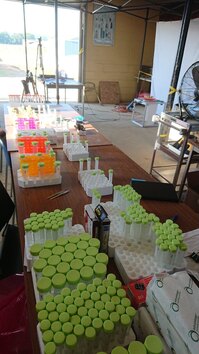Understanding Supply and Support Trade-offs in Maize Aerial Roots

Team: Erin Sparks and Amanda Rasmussen
Funded by: Royal Society International Exchange funding
Years: 2021-2023 (ongoing)
A growing world population, increasing frequencies of extreme weather events, and a need to reduce the carbon footprint of agricultural systems provides a complex challenge for plant biologists. To understand how to solve this complex challenge, we need to understand the trade-offs between optimizing different plant functions. Maize is the most grown crop globally providing food for people and livestock and also serves as an important biofuel. However, maize is susceptible to being blown over, which dramatically reduces yields and makes harvests impossible. My collaborator (E. Sparks) has shown that maize has a unique adaptation in the form of aerial roots (called brace roots) that provide additional support. My lab (A. Rasmussen) is exploring how the different types of maize roots take up nutrients and water and move them around the plant under stressful environments. Together, we queried – is there a trade-off between optimizing roots for stability and their ability to uptake nutrients and water? This exciting cross-disciplinary project will combine Rasmussen’s expertise on resource supply with Sparks’ expertise on mechanical support to determine whether we can identify germplasm that optimizes both strength and resource capture and movement. We will unravel what controls the trade-off between supply and support to understand the boundaries so we can optimise maize varieties for local conditions, providing farmers with the best chance at future-proofing their farm and our food supplies.
Publications:
Findimila Dio Ishaya and Amanda Rasmussen; Quantifying nitrogen uptake rates of maize roots using stable isotopes; Cold Spring Harbor Protocol (accepted 2024)
Findimila Dio Ishaya and Amanda Rasmussen; methods for measuring nutrient uptake in maize using nitrogen stable isotopes Cold spring Harbor Protocol (accepted 2024)
Sparks, E.E. and Rasmussen, A. (2023), Trade-offs in plant responses to the environment. Plant Cell Environ, 46: 2943-2945. https://doi.org/10.1111/pce.14689
Kamei T*, Ikiriko II*, Abernathy SM, Rasmussen A and Sparks EE. “Brace Roots” Submitted to WikiJournal of Science, 2023.
Rasmussen A*, Erndwein L, Stager A, Reneau JW and Sparks EE*. “Bigger is better: Thicker maize brace roots are advantageous for both strength and nitrogen uptake” bioRxiv, 2022.
Funded by: Royal Society International Exchange funding
Years: 2021-2023 (ongoing)
A growing world population, increasing frequencies of extreme weather events, and a need to reduce the carbon footprint of agricultural systems provides a complex challenge for plant biologists. To understand how to solve this complex challenge, we need to understand the trade-offs between optimizing different plant functions. Maize is the most grown crop globally providing food for people and livestock and also serves as an important biofuel. However, maize is susceptible to being blown over, which dramatically reduces yields and makes harvests impossible. My collaborator (E. Sparks) has shown that maize has a unique adaptation in the form of aerial roots (called brace roots) that provide additional support. My lab (A. Rasmussen) is exploring how the different types of maize roots take up nutrients and water and move them around the plant under stressful environments. Together, we queried – is there a trade-off between optimizing roots for stability and their ability to uptake nutrients and water? This exciting cross-disciplinary project will combine Rasmussen’s expertise on resource supply with Sparks’ expertise on mechanical support to determine whether we can identify germplasm that optimizes both strength and resource capture and movement. We will unravel what controls the trade-off between supply and support to understand the boundaries so we can optimise maize varieties for local conditions, providing farmers with the best chance at future-proofing their farm and our food supplies.
Publications:
Findimila Dio Ishaya and Amanda Rasmussen; Quantifying nitrogen uptake rates of maize roots using stable isotopes; Cold Spring Harbor Protocol (accepted 2024)
Findimila Dio Ishaya and Amanda Rasmussen; methods for measuring nutrient uptake in maize using nitrogen stable isotopes Cold spring Harbor Protocol (accepted 2024)
Sparks, E.E. and Rasmussen, A. (2023), Trade-offs in plant responses to the environment. Plant Cell Environ, 46: 2943-2945. https://doi.org/10.1111/pce.14689
Kamei T*, Ikiriko II*, Abernathy SM, Rasmussen A and Sparks EE. “Brace Roots” Submitted to WikiJournal of Science, 2023.
Rasmussen A*, Erndwein L, Stager A, Reneau JW and Sparks EE*. “Bigger is better: Thicker maize brace roots are advantageous for both strength and nitrogen uptake” bioRxiv, 2022.